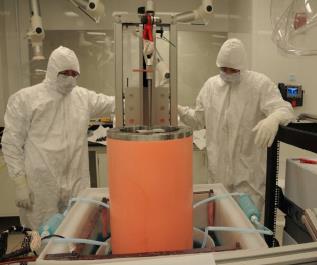Advanced Computing, Mathematics and Data
Research Highlights
August 2013
Detecting the Secrets of the Universe Deep Underground
Using advanced detection techniques, scientists will attempt to detect a Majorana Particle.

Electroformed Copper is being produced in PNNL's Underground Laboratory and at the Sanford Underground Research Facility. Large parts of the detector are fashioned of the ultrapure Copper produced through electroforming.
Results: Working as part of a collaborative team, Pacific Northwest National Laboratory (PNNL) is bringing its signature capability in ultra-low-level detection to help search for a rare form of radioactive decay—never before detected—called “neutrinoless double beta decay” (0νββ) in germanium (76Ge). If observed, 0νββ would demonstrate neutrinos are Majorana-type particles. This discovery would show neutrinos are unique among fundamental particles, having a property whereby the matter and anti-matter version of this particle are indistinguishable. Scientists from PNNL, in cooperation with nineteen other collaborating institutions, are developing the necessary equipment to detect and measure the properties of these rare particles. Ultrapure electroformed copper created in the Shallow Underground Laboratory at PNNL and the Sanford Underground Research Facility (SURF) is key to the success of the detection technology.
Why it matters: Measuring the Majorana nature of neutrinos, from the previously unobserved 0νββ process, would give clues about the formation of the universe and why we observe more matter than antimatter in the universe. The indistinguishable nature of matter and anti-matter neutrinos, if observed, would act as a window to better understand the detailed relationship between matter and anti-matter and how the universe likely began as an equal mixture of matter and anti-matter but cooled and expanded into a state composed primarily of matter.
These results would constitute a paradigm shift. The Standard Model of Physics relies on the conservation of lepton number in which the lepton number is constant through an interaction, in this case that the same number of matter beta particles (β) are emitted as anti-matter neutrino (ν) particles. This would have to be true if neutrinos were massless particles. However, experiments measuring neutrinos produced in the Sun, nuclear reactor cores, and in the atmosphere from cosmic rays have determined that at least one of the neutrinos have mass, although that mass cannot be determined by these types of observational experiments. Massive neutrinos are a requirement for the existence of the 0νββ process and thus the 0νββ process also provides a method for understanding the mass scale of the neutrino.
As a spin-off benefit, the technology used to detect this decay informs the design of other detection technologies for use in environmental and national security applications, where precision and ultra-sensitive measurements of radioactivity are crucial.
Methods: The MAJORANA DEMONSTRATOR Project is a coordinated effort to create a radiation-free environment for measuring the ultra-rare 0νββ process. Every element of the project centers on eliminating the effects of radiation backgrounds on the detection equipment. Starting with the electroformed copper in shielded environments and moving the detector nearly a mile underground to avoid background cosmic radiation, every effort is being made to ensure that the detection of neutrinoless double beta decay is unambiguous and coming from the source material (76Ge) and not from some other uncontrolled source.
Pacific Northwest National Laboratory is leading the production and assay of the major ultrapure materials required to accurately measure the Majorana nature of the neutrino. The equipment is so sensitive that exposure to the naturally occurring cosmic radiation outside of the underground laboratory will cause results from the experiment to be contaminated. Electroforming of ultrapure copper is one way to ensure that any radioactive isotopes in the copper are limited, making it more capable with measuring the rare 0νββ process.
What’s next? Currently, the MAJORANA DEMONSTRATOR Project is completing the necessary creation of the detection technology for observing 0νββ the mass of a neutrino. Over the coming years, the refined germanium (76Ge) that makes up the source for 0νββ, and also the detectors of the experiment, will be observed for evidence of neutrinoless double beta decay. If successful, the experiment will be scaled up and collaborative efforts between the MAJORANA DEMONSTRATOR Project and the European GERDA (GERmanium Detector Array) Experiment will be leveraged and scaled to create a larger tonne-scale experiment to further refine the properties of the neutrino.
